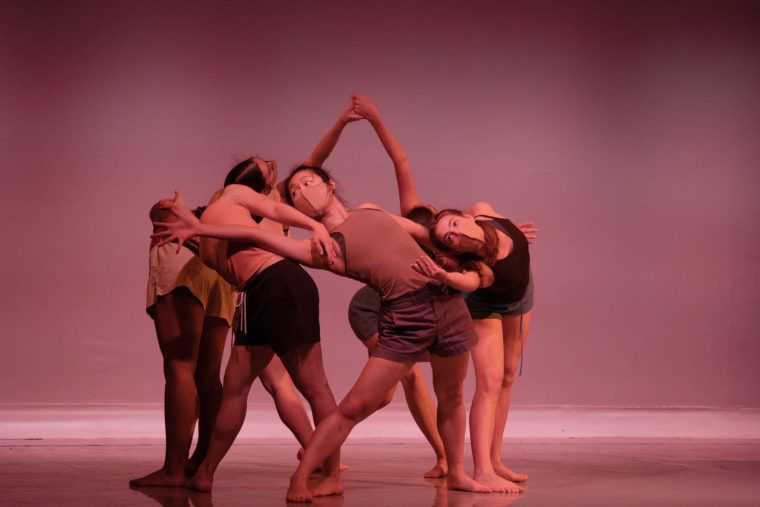Cadenza | Dance
‘Goldilocks Phenomenon’ explores longing and community

All dancers lean on each other during the fourth section of the performance to form a cohesive, multi-limbed being. Photo by Curran Neenan | Student Life
The lights rise, blue and red, on an empty stage. A single dancer creeps onstage, arms outstretched in a mimicry of balancing, on her toes to make no noise. She falls to the ground, begging on the floor in a harsh red light. She is utterly alone.
Grace Meyers’ dance thesis “The Goldilocks Phenomenon” relates the experience of wordless connection and the crippling loneliness that precedes it. Goldilocks (Grace Philion) crawls across the stage in the Annelise Mertz Dance Studio toward three other dancers — two parents carrying and playing with their child. Their peach-hued domesticity is all Goldilocks wants, and she revels in this fantasy in their empty home until she knocks over the stage’s single prop: a wooden chair at center stage. Upon the family’s discovery of the intruder, she flees.
Even when Goldilocks is joined onstage by other dancers, they shove her around. She wears a dress while they wear shorts and tanks; she is still alone even within the crowd. With the haunting music and stark lighting, these dances evoke an almost palpable emptiness. Goldilocks longs for connection that she is unable to achieve, and the pain of her wordless performance — which feels less like a performance than a voyeuristic exploration of a psyche — translates directly to the audience.
The dances slowly move beyond that pain, with more dancers filling the stage and moving together rather than separately. The second part stars two dancers, one in a dress and one in a neutral shirt and shorts. Sometimes, they mirror each other, then break apart in what feels like a fight despite no harsh gestures. Occasionally, the fluid motions and entwined poses evoke an almost erotic context, so that when one leaves the stage, it feels like the end of a relationship, played before the audience in only a few minutes.
That sadness, which the dancer shares with Goldilocks in a moment of absolute silence, does not last. The second dancer re-enters, and their dance together rebuilds the trust and connection lost during the interlude. The first dancer cautiously removes her dress, the outfit underneath matching her partner’s, and from here, she is no longer alone.

A tentative exploration of trust in the second section of “The Goldilocks Phenomenon.” Photo by Curran Neenan | Student Life
The final two parts of the performance show first a fragmented whole, three parts of the stage filled with different dancing. Six dancers float from area to area, moving austerely and gracefully, slowly struggling to stay standing and moving frantically as though clawing bugs off the skin. Every time one dancer falls, the other five rush to catch her in a choreographed trust fall, and by the time the lights go down, all six lie atop each other. No longer alone, the dancers trust and love each other, beginning to form a community.
That community achieved, in the last section the six dancers move as one. Goldilocks has shed her isolation, moving toward a group identity and what, in subtle contrast with the haunting music, may be joy. If not joy, certainly belonging.
“The Goldilocks Phenomenon” touched these emotions on a profound level. One of the first dance performances to take place in person since spring 2020, the experience of seeing the show live both removed some of the ethereality and added a touch of humanity. All the dancers were barefoot, the floor squeaking as they moved. In difficult poses, their arms and legs visibly shook. But the markers of effort only added to the piece’s effect, refusing to let the audience forget themselves in the performance and forcing them to contemplate the reality of the experiences presented before them.
